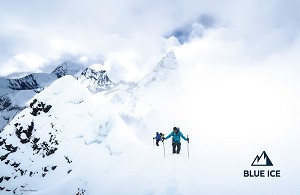
If the snow's deep but you're not up for skiing, then snowshoes might make the difference between a slogfest and a fun day out. Snowshoe-agnostic Dan Bailey finds himself won over by this capable model from MSR.
Described as the 'pinnacle of ultralight and aggressive all-terrain performance', the Lightning Ascent is the model in MSR's extensive snowshoe range that's best suited to the rough - and often steep - ground found on most UK winter hill walking routes. This is the update to a model that's been around for years and is generally highly rated, the key change being a new and allegedly more comfortable binding system. If your snow seeking takes you to higher elevations and more challenging places, this is a capable, user-friendly, and confidence-inspiring design, which has the build quality to last for years.
The Lightning Ascents have led me to reconsider my attitude to snowshoes, which was - I'll admit - a little sceptical before now. In fact the only thing counting against them is the steep price tag.
Really...? Snowshoes...?
It's the UK, not the Yukon. Far from being an everyday essential, snowshoes clearly fall in the category of occasional-nice-to-have. Full-on winter conditions can be fleeting here, snow depths are generally not that great, and much of the ground you cover on a typical day out is likely to be wind-scoured anyway. Yet there are still spells most winters, particularly in Scotland, where travel without some kind of snow-flotation is onerous at best, implausible at worst.
If you own a ski touring or nordic setup then that's clearly the way to go, because skiing is smoother, faster and just more fun. But we don't all have the skills, or the budget to blow on a bewildering choice of ski gear. With a pair of snowshoes you need no expensive or lengthy tuition, you can quickly and safely teach yourself. Better still, they'll work with your existing winter walking boots. And they're less hassle strapped to a pack - think overnight backpacking in the hills for instance. Snowshoeing may be the pedestrian option, but it's also cheaper and not as much faff. And on the right day a pair may well make the difference between getting up your snowy Munro and having a brilliant time, or trudging to a standstill halfway.
In use
Sturdily built, with a comfortable and easy-to-fit binding system, the Lightning Ascent feels like a very competent all-terrain model. Light enough for bimbling around forest trails, or for use on the snowy approach to a continental ice climb, they also have the grip and manoeuvrability you need on the steeper, rougher and icier ground found on your average Scottish winter hill day. A larger surface area is going to give you more flotation on the snow, and alternative bigger snowshoes are indeed available; however a larger deck would also be more cumbersome, and I feel the Lightning Ascent strikes a sound balance between lift and dexterity. For extra lift an additional tail piece can be bought separately, though I can't picture an occasion in the UK where I'd be likely to want this.
In the North Highlands we've had a couple of big low-level snow dumps so far this season, allowing me to use the Lightning Ascent on afternoon walks virtually from the doorstep - a welcome alternative to wading boot-deep in the woods.
They also proved their worth on a very snowy early season ascent of Ben Wyvis. It was a day when skiers were setting the pace and those without were giving up at the treeline. Only one very determined walker made it to the top, and his post-holing crawl looked agonising. By contrast the Lightning Ascents gave me enough lift to float over the worst of it, so while progress was still far from effortless they really did make all the difference.
Deep cover on the lower slopes gave way to a patchwork of wind scour and drifts higher up. Where the ground steepened on An Cabar I found the snowshoes more than capable. Their sharp-toothed aluminium frame bites into ice and neve with ease, whether you're traversing, climbing or descending, while a hinged crampon at the toe gives extra uphill grip. As with a ski touring binding, to take the strain off the calves in uphill mode a heel bale can be popped up (using the tip of a pole). MSR's comically grand name for this is the Ergo Televator; I'll just call it a flap, but either way it's simple and effective.
Until receiving these to review I had not been a regular snowshoer, but it didn't take long to adapt my stride. It needs a high leg lift, and a wide stance to avoid slicing your inner ankle with the opposite foot - something the kick patches on my overtrousers have taken the brunt of when following narrow ski tracks. Perhaps the sharp-edged metal frame of this design is particularly prone to trouser-cutting, but on the other hand it's great for traction. On rough ground these things are easy to handle, and about as uncumbersome as I can imagine it ever feeling with great big platforms strapped to your feet. For the varied terrain of a Scottish hill, one step heather, then ice, then deep powder, they're a proper 4x4.
Using the Lightning Ascents, I'm sure you could get by without crampons a lot of the time; but on a typical UK winter hill day you might encounter all sorts of conditions including lots of ice, and because of this uncertainty I've not yet been able to bring myself to leave the crampons at home. This does of course mean carrying two sets of stuff instead of just one.
Sizes
The Lightning Ascent comes in both men's and women's versions - and before you scoff, the material difference is a narrower frame and smaller foot binding on the female model. The men's snowshoe is available in three lengths, 22, 25 and 30 inches (MSR being American). Which one is right for you depends on both your body weight and the type/depth of snow - as described in a useful size chart on the MSR website. Being about 80kg in weight, and not expecting to be out in 'deep snow' (60cm+ by their definition), I opted for the mid range 25 inch size, which seems to offer a good balance of flotation, manoeuvrability, lightness, and easy carrying on a rucksack.
Weight and robustness
With their high grade alu frame and durable nylon decking these things are built really solid, and should take loads of abuse - even scraping on rocks and heather (let's face it, Scotland is not the environment they were primarily designed for).
Per pair, the mid-sized men's 25-inch model weighs 1.95kg (1.8kg for the women's equivalent), and although fairly long they do strap neatly to the side of a day pack - you'll want a big one. It's a significant addition on top of the other winter essentials already weighing you down, but for something this big and sturdy I don't think it's at all unreasonable.
On the feet they add to the heft of whatever (presumably warm and chunky) footwear you've picked, and you will certainly notice them since weight on the feet increases fatigue over a long day. But is it really much worse than a pair of crampons? If the snowshoes make the difference between summit or retreat then they'll fully justify their weight and bulk.
Lighter - and cheaper - plastic snowshoes are available, but it's unlikely any offer comparable durability or traction. For something this rugged and capable the Lightning Ascent seem to be at the lighter end of the scale - but not by much. By comparison MSR's own 25-inch Revo Ascent snowshoe weighs 2.14kg, while among alternative makes the Tubbs Flex Alp 25, which looks to have a fairly similar remit, is 2kg.
Bindings
Some snowshoe bindings look fiddly or otherwise mediocre, and I once even had a pair (generally fairly useless) that required you to be wearing crampons; but MSR have clearly put a lot of thought into the bindings on the most recent design of the Lightning Ascent. This Paragon Binding (does every feature need a name?) consists of a soft plastic mesh that wraps evenly and snugly around the toe, without pressure points that might dig in or restrict your circulation. It's secured with three stretchy rubber straps that let you very easily and securely tighten the fit right up. The metal buckles are simple, effective, sturdy, and won't ice up. A couple of minutes is all it takes - less faff than getting into most crampons. This binding fits a wide variety of shoe sizes and types of footwear. I've been sticking with B1 and B2 boots, for the warmth, and have yet to find a pair that don't work well.
Ethics and environment
The ones for sale here are made in Ireland, which reduces the carbon impact of distribution (apt for a product that can only be used in snow). Being so well built, they're really the opposite of a disposable product, and I don't imagine I'll ever need to get a new pair.
Summary
If you're looking at deep snow on the hills, and you're not up for skiing, then snowshoes are a good compromise option that might make the difference between a slogfest and a fun day out. On steeper, rougher ground the Lightning Ascent are generally considered to be among the most capable models on the market - not cheap, but well made and well designed. I was a bit agnostic about snowshoes in the past, but they easily won me over.
















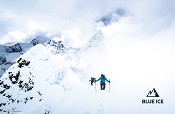
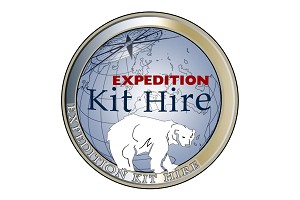

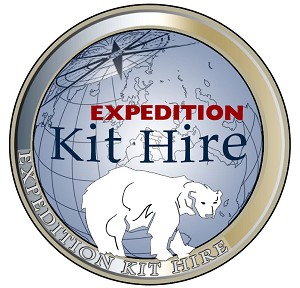
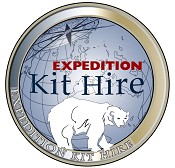



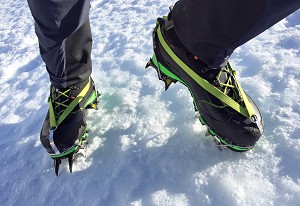
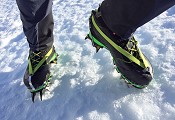

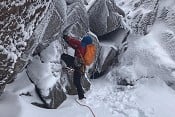
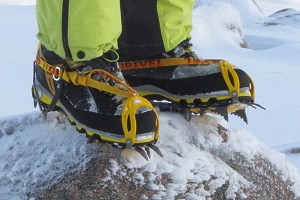
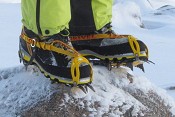
Comments
I can add a bit on longer term usage of MSR Lightning snowshoes, having bought a pair when I lived in Finland and used them a lot there, and a little since moving back to the UK a decade ago, although a section of the hinge snapped maybe five or six years ago and I haven't used them since. So once again this review is reminding me to email MSR to see if I can buy just the replacement part and get mine up and running again!
In Finland I used them a lot in the lower firmer snow conditions of the south. These size of snowshoes are pretty hopeless in the powdery, untransformed snow conditions that are far more normal in forested areas in Lapland - they simply don't have enough floatation. I used mine a lot in while prospecting for ice falls which generally meant crashing through forest a lot, so would often be putting them on protruding rocks and on fallen lumber. Probably not to dissimilar from the snowier parts of Scotland. The nylon deck and the steel frame survived that very well but as noted above it was a metal plate on the hinge mechanism that broke on mine.
Dan mentions using ski tracks to help find consolidation and in the Highlands I can't imagine anyone could possibly object to doing this, but just a word of warning to anyone going somewhere with purposely laid XC ski tracks - XC skiers tend to loath people walking or snowshoeing on prepared tracks. Don't do it! XC poles can be up to 2 mtrs long and have a wicked spike on the end, you don't want to get into a fight with an XC skier! I know in lots of popular places now for XC they also have separate and distinct snow shoe trails to avoid this conflict.
I’ll add to this with a plea not to snow shoe over ski touring tracks in general! A skin track can last weeks and generally just gets better with use, but just one snow shoe over it trashes it completely! And also doesn’t generally help much for the snow shoeing as it isn’t dense enough packed to stop you sinking in anyway. (bone of contention in popular touring areas here in NZ)
Best snowshoes for the snowshoe-sceptic climber are surely: https://www.snowplak.com/en/product/snowplak-approach/ . Super light, no moving parts and fit over crampons.
My thoughts as a keen snowshoer:-
There are two sorts of snowshoes, 'trail' ones and 'mountain' ones - trail ones are rubbish on slopey ground, my wife's just been on a snowshoeing course at the weekend and the instructor who was teasing her about her old, big, 'heavy' Denali Ascents had to wind his neck in when she was happily tromping up and down the slopes and her fellow students in trail snowshoes were sliding around. MSR's mountain range are the 'ascent' models by the look of things. The confidence you get on steep ground is amazing, I feel like I'm some kind of indestructible tank as I go straight up stuff I couldn't do in summer in hiking boots. NB. this could get you into trouble in terms of avalanche terrain, but it gives an idea of the grip you get.
Catching your legs - as a user of old Denali Ascents with a plastic floatation area I can say that it must be the metal perimeter on the Lightning ascents tested that is the issue - much of my snowshoeing is on twisty rough terrain in woods, and over buried dwarf pines resulting in me hitting my legs all the time, and I've had no catching or damage at all.
Size - I'm ~85kg in jeans, jumper and trainers, so easily 90+kg with all my kit (winter clothing, daypack with lunch, emergency gear inc shovel, bumsledge, poles). The add-on tails are definitely useful in anything soft. They can be a pain in rough terrain - where there are shallow boulders, tree roots or other buried stuff making the shoe sink in different depths at different parts of the shoe, or where you're doing lots of turns (e.g. zigzagging up/down a slope), but the rest of the time they're well worth it.
Crampon use - I'm intrigued as to the need to continue to carry crampons, Dan - where do you find the snowshoes don't provide enough grip on ice? Is it because the large grip area results in the teeth not penetrating deep enough (all your weight on dozens of points instead of 10)? I've only come across ice once - on a broad wind-swept ridge where freeze-thaw had resulted in it becoming a sheet of clear ice and had no trouble in the Salewa 999 snowshoes I was using. I can see steep, rocky terrain being an issue where you can't fit the shoes in between rocks, or where the ground is too uneven, but would you want to be wearing snowshoes there anyway? I don't do UK winter stuff, so am just curious and want to learn before I find myself in trouble!
Expense and quality - I'd have no hesitation in buying secondhand MSR snowshoes if new ones are too pricey - my Denali Ascents are easily 10 years old and are still going strong. The straps, however do lose their suppleness, crack and break. Replacements are easily sourced online.
From seeing recent posts on social media from MRTs and others making the most of the recent snow in the UK I'd strongly recommend using snowshoes. The major advantages are
a) not post-holing and getting wet feet/legs, or unexpectedly post-holing into a twisted ankle situation when you plunge through powder only to hit uneven ground and roll your ankle, or get it trapped between boulders. I've happily walked on top of snow that others have post-holed up to their groins every step!
b) not slowing down. I'm doing virtually the same pace with snowshoes as I get on similar terrain in summer.
If you have to carry them up a climbing route they may be more hassle than they're worth, but for winter walking it's a no-brainer.
Have you used them? As they're not articulated, do they not have a lot of resistance when you're lifting your feet?